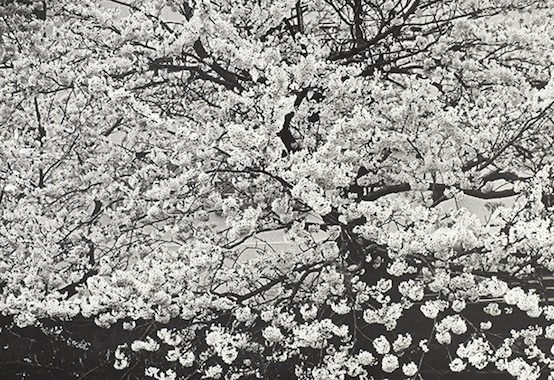Disorientation: “Sense of Place” at the Sackler Gallery

Now that the shutdown is over, I can tell you about a small but punchy photography exhibit at the Sackler.
“Sense of Place,” which runs through November 11, disrupts many of the cliches of East vs. West. In these tired oppositions, Europe is a clash of swords and horses; China, Japan, or any other part of the undifferentiated East is a lone monk crossing a quiet pond. The West is the land of change and history, the East is the land where life is as fleeting and yet eternal as the seasons.
Well, there is a lone man crossing a quiet pond in “Sense of Place.” Hai Bo’s image is gentle, sad and misty, as a bridge arches in graceful curves over the placid water. But this is only the first in a series of three images. The bridge is destroyed. The man is left wandering in a foggy forest, and then abandoned among concrete structures under a blank white sky. In just three photographs we’ve entered the modern world: a world of industrialization and rapid change. Despite the exhibit’s title, time rather than place is the major theme of the small show—it takes up only two rooms—and the emphasis is on the aftermath of distinctly twentieth-century destruction in China, Japan, Iran, and Vietnam.
The show opens with two striking photos by Moriyama Daido. They have contrasting subject matter: “Yumenoshima” depicts a landfill, while “Cherry Blossoms” depicts a tree in bloom. But both photos have a similar modern, off-centered, propulsive feeling. “Yumenoshima” uses a heavily tilted angle to throw the viewer off-balance, and a white expanse of sky above the rubble conveys a sense of loneliness and meaninglessness. “Cherry Blossoms” doesn’t show any sky at all; the whole frame is filled with the blossoms which seem to explode out from the tree, against a black background which dims at the edges. It’s the most aggressive cherry blossom tree I’ve ever seen. Both photos are reminiscent of the extreme angles and high emotional pitch of Surrealists like Lee Miller.
In the larger, second room of the show we do get to see human beings. Seifollah Samadin’s photographs of rural life in the aftermath of the Iran-Iraq War are the show’s most powerful images. Their long titles explain what’s going on in the pictures, but also serve to shape and confound viewers’ expectations: “A young boy helping his father in their pottery factory” might sound like it shows an interior, domestic scene, maybe even an actual father, but in fact we just see the back of the boy as he jumps down from a huge stack of jars. It’s a gorgeously-framed picture, the crouching boy with his hands spread for balance against the sky, his back to the camera. We don’t see his face, just the black, empty mouths of the jars.
“An Iranian fisherman being shaved by his colleague” is even more unexpected. This time we do actually see both people we were promised by the caption, but they’re completely alone in a wasteground crisscrossed by track marks and studded with a couple of spindly trees. If you’ve ever wanted to see Vladimir barber Estragon, this is your chance. The vulnerable angle of the exposed neck and the curve of the barber as he bends to his task evoke empathy since they’re the only human features of this devastated landscape.
The gentlest pictures in the show are An-My Lé’s chronicles of Vietnamese agricultural life. Here we see cultivation and fruitfulness, depicted with normal framing in settings full of animal and vegetable life. Families hold their children on their hips and white ducks get herded into their enclosure. There are no disorienting tilted frames and no huge, awful, empty sky. But this too represents change, catastrophic change and slow recovery, since the twentieth century in the Mekong Delta was anything but peaceful.
“Sense of Place” is the first in a series of exhibits on contemporary Asian photography. It subtly emphasizes the continuity between Western and Eastern experiences of modern life: disruption, abandonment, absurdity.
Comments